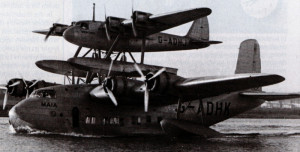
Do you know where you were on Tuesday, February 6th, 1938? I was standing in short trousers with freezing knees in the middle of Rochester Bridge, spanning the River Medway. My dad was with me, as was most of the local population. This was a momentous day, one that would never be repeated.
“History in the making,” said Dad.
I didn’t like the sound of that; it seemed too much like a school lesson. I hoped that I wouldn’t have to write an essay on whatever was going to happen today. At least I had the day off school. Dad had decided that this event was as educational as anything I would be taught there today.
The river was awash with boats. If 1 had fallen from the bridge, it wouldn’t really have mattered. I would probably have landed no more than four feet from a dinghy, and would soon have been hauled aboard. Police and rivermen were frantically scuttling about the river like agitated water beetles, shepherding all the vessels back to the shore in order to clear the middle of the river for the big moment.
Way up river, almost out of sight, floated a large seaplane. From my vantage point it looked as if a smaller aircraft had landed on top of it. After what seemed hours I said, “Dad, can we go home now? I’m cold and nothing’s happening.”
“Just wait a little longer, son,” said Dad. “This is history in the making.”
“You’ve already told me that,” I muttered. History was for schools, not for freezing one’s knees on a bridge in February.
One of my shoelaces had worked loose
and I was about to bend down and fix it when Dad said, “Here it comes!”
I heard a dull roar like thunder in the distance. I realised that the noise was coming from the flying boat with the little one on top. As it came nearer I could see that all eight propellers, four on each aircraft, were spinning like mad. Gradually a bow wave formed under the floats and body of the large one. I could see the name Maia painted on it. I learned later that the smaller one was the Mercury. The noise grew to horrendous proportions and, combined with the cheering of the crowd, made the seagulls fly away in protest.
The aircraft picked up speed and lifted just a little out of the water, then settled down again. Suddenly, when it appeared too late to avoid crashing into the crowded bridge, the machine leapt into the air and roared over our heads with enough noise to split the heavens in two.
It was the first ever successful flight of a small plane playing piggyback on a larger one, and separating without a hitch.
Even now, more than 70 years later, whenever I cross Rochester Bridge I can see the gigantic Maia with Mercury perched on top, labouring to gain enough height to clear the bridge on its way to far-off lands. My feet remember the way the structure had vibrated with the passing of that giant
airborne mass. It was over, the aircraft disappearing out of sight before we could hear again.
Grand finale
There was an after-effect that nobody had thought about. When the aircraft took off, it pulled with it hundreds of gallons of Medway water and drenched the crowd under its path. Such was the excitement that the soaking was treated as part of the show. There were impromptu competitions in various sections of the throng to see who had the wettest clothes. I awarded myself a point because, as well as being wet through,
I was minus a shoe, which had dropped into the river and was now floating merrily downstream.
Later, when I realised what I had witnessed, I thanked Dad for making me stay the course. On July 21st, a news bulletin announced that the Mercury had been successfully air-launched over Foynes, in Ireland, to fly to Montreal, Canada. In October, it established a non-stop seaplane record of a fraction under 6,000 miles to South Africa.
The Maia took part in WW1I and I felt a twinge of regret when it was destroyed by enemy fire in May, 1941. Nevertheless, that day in February was one to remember.
Thomas Parr, Old Windsor, Berkshire








